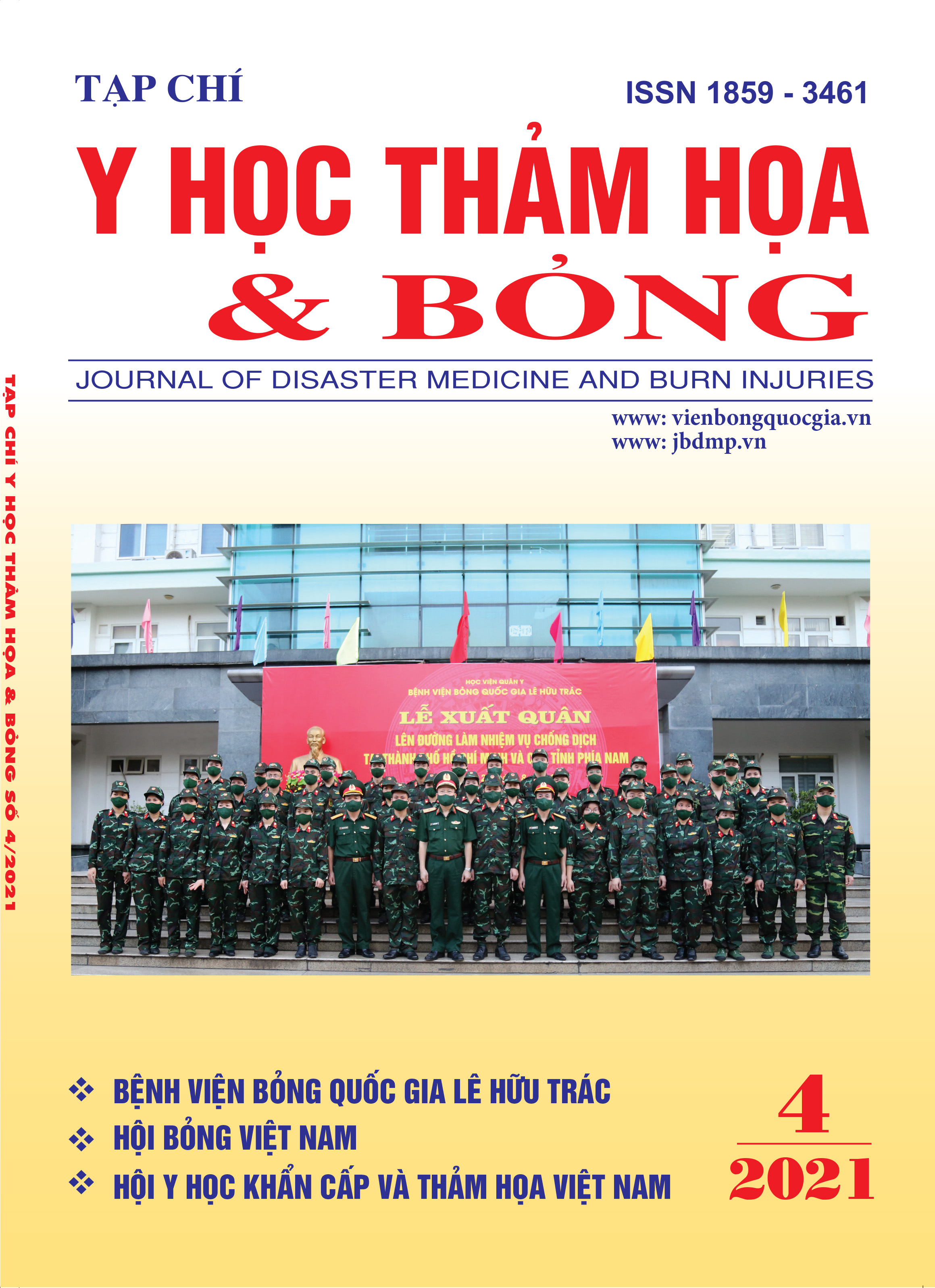Characteristics and the treatment challenges of adult burn patients.
Main Article Content
Abstract
Aims: Investigating characteristics, outcome and the treatment challenges of adult burn patients.
Subjects and methods: A retrospective study was conducted on data of adult burn patients admitted to National Burns Hospital from the 2008 year to the 2017 year.
Results: The male to female ratio was 2.7/1. Patients from rural areas accounted for 72.36%. Almost all adult burn patients had not the health insurance (58.51%). The most common age group was 20 to 39 years old (63.83%). Dry heat and electricity are the most common causes of burns, at 56.91% and 24.8%, respectively. The mean area burned was 9% (3 - 20%) total body surface area (TBSA), the average area of deep burns was 0 - 4% TBSA. The percentage of patients with respiratory burns was 3.83%. 0.94% was the figure for combined injury.
The length of hospital stay (LOS) is 12 days ( from 7 - 23 days). Electrical burns last most treatment days, followed by dry heat burns. The death rate of inhalation injury patients was 75.1%. The LA50 index (Lethal area 50 index) was 64.26%, the LA50 of deep burns was 35.68%. Electrical and dry heat burns were the cause of broader burns, more extensive burn areas, and have a higher combined injury rate and a higher rate of respiratory burns. Overall mortality was 4.6%, mortality rates were higher in uninsured, dry heat burns, electrical burns, respiratory burns, and combined trauma.
Conclusion: There are still many challenges in the treatment of adult burns, especially dry heat burn and electricity burn are large challenges of treatments, which cause longer hospital stays and high mortality rates. In addition, health insurance must also be mentioned.
Article Details
Keywords
Adult burns, , challenges, outcomes, death
References
2. Trần Đoàn Đạo (2015), Tình hình điều trị bỏng và di chứng bỏng tại bệnh viện Chợ Rấy trong 3 năm 2012 - 2014. Y học thảm họa và Bỏng.2/2015: 25-29.
3. Ortiz-Prado E., Armijos L. and Iturralde A. L. (2015), A population-based study of the epidemiology of acute adult burns in Ecuador from 2005 to 2014. Burns.41 (3): 582-589.
4. Wang T., Nie C., Zhang H.. et al (2018), Epidemiological characteristics and factors affecting length of hospital stay for children and adults with burns in Zunyi, China: a retrospective study. PeerJ.6: e5740.
5. Nickel K. J., Omeis T. and Papp A. (2020), Demographics and clinical outcomes of adult burn patients admitted to a single provincial burn center: A 40-year review. Burns.
6. Seo D. K., Kym D., Yim H.. et al (2015), Epidemiological trends and risk factors in major burns patients in South Korea: a 10-year experience. Burns.41 (1): 181-187.
7. Iqbal T., Saaiq M. and Ali Z. (2013), Epidemiology and outcome of burns: early experience at the country's first national burns centre. Burns.39 (2): 358-362.
8. Li H., Yao Z., Tan J.. et al (2017), Epidemiology and outcome analysis of 6325 burn patients: a five-year retrospective study in a major burn center in Southwest China. Scientific reports.7: 46066.
9. Ye C., Wang X., Zhang Y.. et al (2016), Ten-year epidemiology of chemical burns in western Zhejiang Province, China. Burns.42 (3): 668-674.
10. Wardhana A., Basuki A., Prameswara A. D. H.. et al (2017), The epidemiology of burns in Indonesia’s national referral burn center from 2013 to 2015. Burns Open.1 (2): 67-73.
11. Elsous A., Ouda M., Mohsen S.. et al (2016), Epidemiology and outcomes of hospitalized burn patients in Gaza Strip: a descriptive study. Ethiopian Journal of health sciences.26 (1): 9-16.
12. Nguyễn Tiến Dũng và Nguyễn Như Lâm (2012), Nghiên cứu các yếu tố tiên lượng tử vong ở bệnh nhân bỏng do tai nạn lao động. Tạp chí y học Thảm họa và Bỏng.1-2012.
13. Hwee J., Song C., Tan K. C.. et al (2016), The trends of burns epidemiology in a tropical regional burns center. Burns.42 (3): 682-686.


